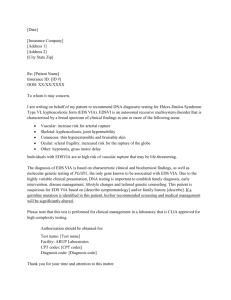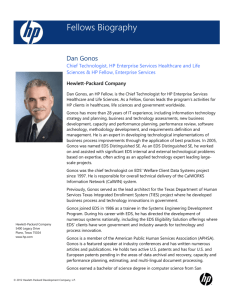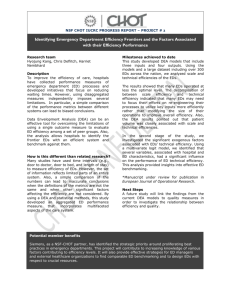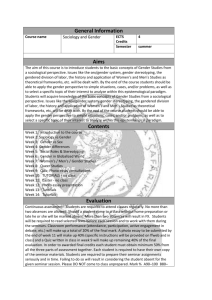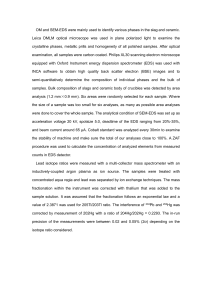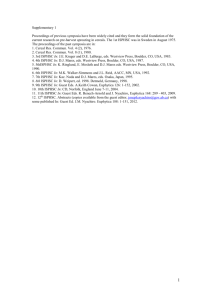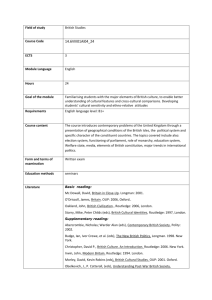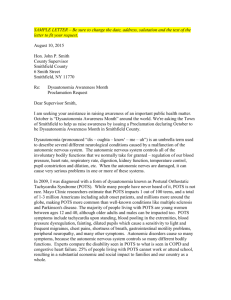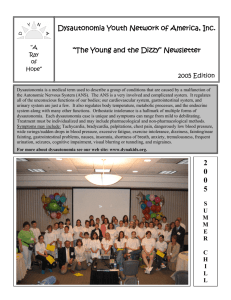Anne Marie`s letter
advertisement
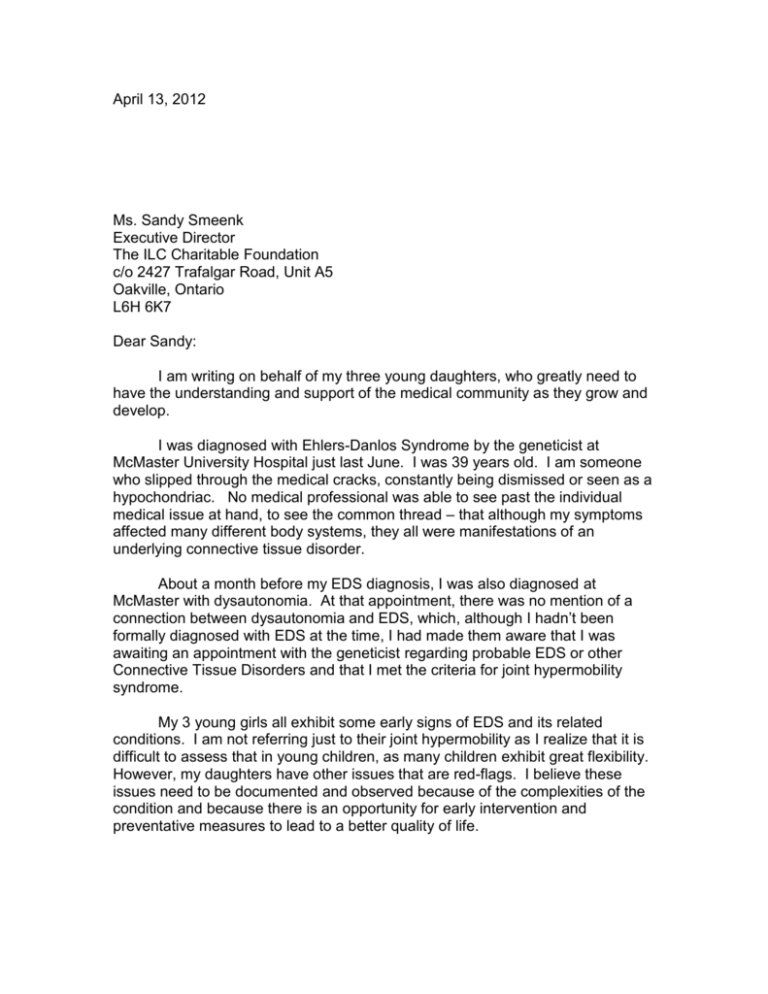
April 13, 2012 Ms. Sandy Smeenk Executive Director The ILC Charitable Foundation c/o 2427 Trafalgar Road, Unit A5 Oakville, Ontario L6H 6K7 Dear Sandy: I am writing on behalf of my three young daughters, who greatly need to have the understanding and support of the medical community as they grow and develop. I was diagnosed with Ehlers-Danlos Syndrome by the geneticist at McMaster University Hospital just last June. I was 39 years old. I am someone who slipped through the medical cracks, constantly being dismissed or seen as a hypochondriac. No medical professional was able to see past the individual medical issue at hand, to see the common thread – that although my symptoms affected many different body systems, they all were manifestations of an underlying connective tissue disorder. About a month before my EDS diagnosis, I was also diagnosed at McMaster with dysautonomia. At that appointment, there was no mention of a connection between dysautonomia and EDS, which, although I hadn’t been formally diagnosed with EDS at the time, I had made them aware that I was awaiting an appointment with the geneticist regarding probable EDS or other Connective Tissue Disorders and that I met the criteria for joint hypermobility syndrome. My 3 young girls all exhibit some early signs of EDS and its related conditions. I am not referring just to their joint hypermobility as I realize that it is difficult to assess that in young children, as many children exhibit great flexibility. However, my daughters have other issues that are red-flags. I believe these issues need to be documented and observed because of the complexities of the condition and because there is an opportunity for early intervention and preventative measures to lead to a better quality of life. My 3 girls all have fallen arches, miserable misalignment syndrome in their legs which twists their hip joints inward, they have bowel issues, frequent stomach aches, growing pains and mild joint pain. They seem clumsy and have many bruises. They have articulation difficulties. They also have urinary dribbling after they empty their bladder, which is especially unusual and embarrassing for a 9 and 11 year old. My oldest and youngest also have a sacral dimple, so of course, with the urinary and bowel issues, (and a family history of spina-bifida and spina-bifida occulta), I believe I am justifiably concerned that there could be tethered cord involvement. Additionally, my 11 year old has been suffering from daily headaches and true Migraines with aura. At school, she often goes off alone at recess to a quiet place in the playground so that she can lie down, or put her head down on her lap. She has recently begun physiotherapy and acupuncture for her migraines and shoulder pain. When the physiotherapist first examined her, he told me her neck was “very unstable”. Her recent appointment at McMaster with the pediatric neurologist confirmed her migraines. During her appointment, the neurologist noted her winged scapula, her pectus excavatum, and her fallen arches. He told me that because of my EDS diagnosis, along with her migraines and the other uncommon physical findings that he noticed, it is “Very Likely” that she also has Ehlers-Danlos Syndrome. My 6 year old had 5 surgeries by age 5. Her eyes didn’t track properly as an infant, but “matured” late. Her ear canals were immature and became chronically infected, requiring multiple operations for tubes, as well as a patch and repair of the ear-drum. She had 6 cavities and a root canal done at age 4 because of deep crevices and soft dentin. She had a tonsillectomy and adenoidectomy at age 3 (with the largest and most scarred tonsils that our ENT had ever seen on a child so young). At age 5, she had surgery for an inguinal hernia. She has ongoing bowel issues, a chronic bloated, swollen belly, and alligator-like skin which itches, cracks and bleeds. My two eldest daughters, aged 11 and 9, were both previously diagnosed with ADHD – combined type. Interestingly, new research suggests a link between ADHD and dysautonomia, with some doctors believing that in the future, ADHD may be found to be a subtype of dysautonomia. Stimulants, such as Concerta, which my two daughters and I all take for ADHD, also help with dysautonomia symptoms. I have heard of this association through the medical specialists at the last EDNF (Ehlers-Danlos National Foundation) annual conference. However, I have heard nothing about that association through any ADHD doctors or psychologists who are making the diagnosis. Surely, the psychologists, psychiatrists, and pediatricians should be aware of dysautonomia and EDS as there is a high co-morbidity between those conditions with not only ADHD, but anxiety and depression as well. Gastrointestinal specialists would also be an ideal specialty to be further educated about connective-tissue disorders. They need to be able to recognize some of the GI manifestations of connective tissue. Nearly all people with EDS have GI involvement. In my own case, it was through a GI doctor that I eventually found my EDS diagnosis. However, it wasn’t something that he suggested; it was my own research that led me to ask him if my GI issues could in any way be connected to my joint hypermobility. He asked me to show him my hypermobile joints. He was the first doctor who took an interest in that and then referred me to a rheumatologist who confirmed joint hypermobility syndrome and referred me further to the geneticist to determine that it was a hereditary connective tissue disorder. I have been determined that my children not go through the years of physical and emotional pain from the health-care system’s lack of knowledge and understanding of their medical issues. I thought that surely, with my diagnosis, things would be better for my children. Surely there would be an understanding of the multisystemic manifestations of EDS. Surely, the doctors wouldn’t dismiss their abdominal cramps and headaches as just “worry”. Surely, they wouldn’t dismiss the constipation or the post-void dribbling. Yet, despite my diagnosis, and the knowledge that each daughter has a 50-50 chance of having EDS as well, there is little that is different for them. The knowledge about EDS and its related conditions has not made its way to the doctors who see our children on a regular basis – to the doctors who have the opportunity for early involvement and diagnosis so that our children can be protected from unnecessary joint damage which will likely cause chronic pain later in life, so that they can get the orthotics and aids that will help the alignment of their spine or hips, so that they can begin an appropriate physiotherapy program so that they can tone their muscles which will have to do extra-duty to hold their joints in place because of the weakened ligaments, and so that they can find ways to manage pain and discomfort, without believing it is “all in their head” and that they just need to “toughen up”. So the information and knowledge is out there…but it hasn’t been transferred to either the specialists or the primary care physicians. For example, I recently informed our pediatrician about my EDS diagnosis, He asked me if the doctors had checked my heart because of the possibility for aortic rupture. When I said “yes – they said it was fine” he responded (in front of my children) with, “Oh well, other than that, EDS doesn’t cause any other difficulties”. Believe me, my daughters know that there are other difficulties. They know of my chronic back-pain and headaches. They know that my shoulder’s can dislocate just from sleeping. They know I often have stomach-aches and that I have insomnia. How are they to interpret their doctor’s dismissal of their mother’s symptoms? How are they to believe that this doctor will help them (or even believe them) when they have pain? I calmly asked that he “observe” our girls, even offering to provide him with the one-page pediatric screening tool from the EDNF. He responded with, “Well, since I don’t know much about Ehlers-Danlos, there’s no point in me learning just a little about it when we could just refer the girls to that geneticist at McMaster who knows about it”. At another appointment, we were discussing my 11 year old’s migrainelike headaches. I told this same pediatrician that I had been recently diagnosed with dysautonomia. In front of my daughters, he said, smirking, “that is just being a woman and having periods”. My concerns go beyond my own 3 daughters. My nieces and nephew also shows signs of EDS. My youngest niece, in particular, was perhaps the most “rubbery” baby I have ever seen. She had delayed walking, and has very poor balance and proprioception. She recently saw a pediatric surgeon at McMaster for her umbilical hernia. My sister told the pediatrician about my EDS diagnosis, and her other daughter’s confirmed “ligamentous laxity in the hips as an infant”. The surgeon decided to wait for a year before he operates, in the chance that the hernia will heal on its own. He told my sister that if she does get a diagnosis of EDS for her daughter before that year is up, then that will affect how they do the hernia surgery. However, no one has referred her daughter to a geneticist, and even had a referral been made, the wait for the pediatric geneticist at McMaster is about 18 months – definitely not before the scheduled surgery. So how do they move forward? Why can’t the surgeon and the geneticist at McMaster discuss the case and make a decision together? There has been tremendous strides in the recognition and diagnosis of Ehlers-Danlos Syndrome and its related conditions such as Chiari, Tethered Cord, Syringyomyelia, dysautonomia and POTS, but we still have a long way to go. One major key is the knowledge transfer and dissemination of information to the medical professionals who have the ability to make positive and substantial improvements to the quality of life for so many children. I believe there are many people in the medical community who wish to learn more – who want to help their young patients. Unfortunately, they are often overwhelmed with the number of patients and don’t have the time to delve into individual conditions – especially ones that are complex and would require many research hours to navigate through the vast information regarding the numerous affected bodily systems and possible manifestations. The ILC can facilitate that process by bringing these health-care professionals relevant and current information, providing them with resources for further investigation and research, and highlighting the personal experiences and insights of leading specialists. Please consider bringing together the leading specialists of EDS with the health-care providers of South-Western Ontario. The ILC Foundation has an incredible opportunity to create a model of excellence by creating awareness and facilitating knowledge transfer so that children and families with these conditions will have fewer challenges to face when navigating through the health-care system. Heaven knows, these children don’t need any additional challenges on top of their ongoing medical issues. But being validated and understood by their health-care providers will be instrumental in how they see themselves as individuals, and how they cope with their ongoing challenges. Thank you so much for your consideration and your passion towards improving children’s lives. Ann-Marie
